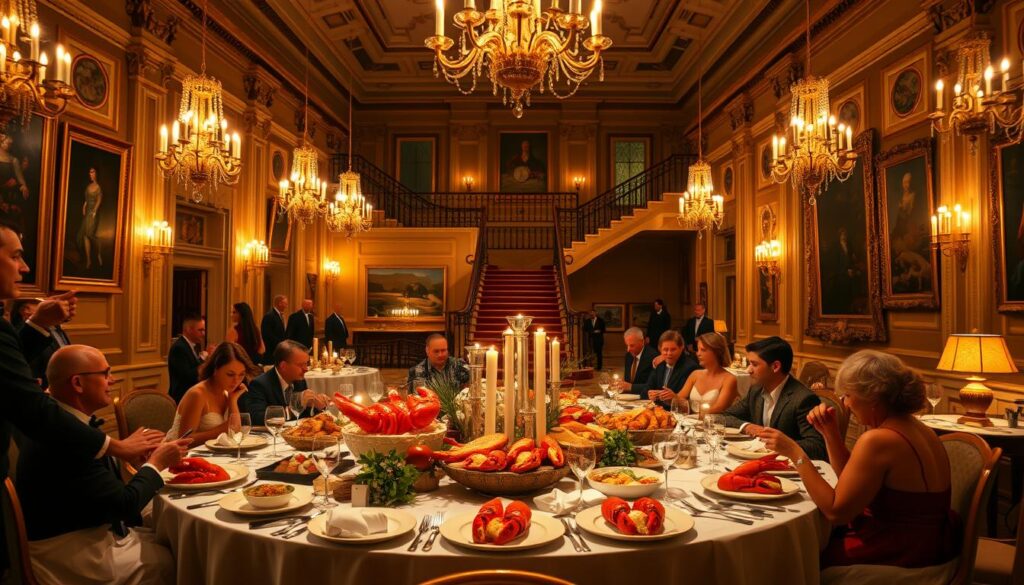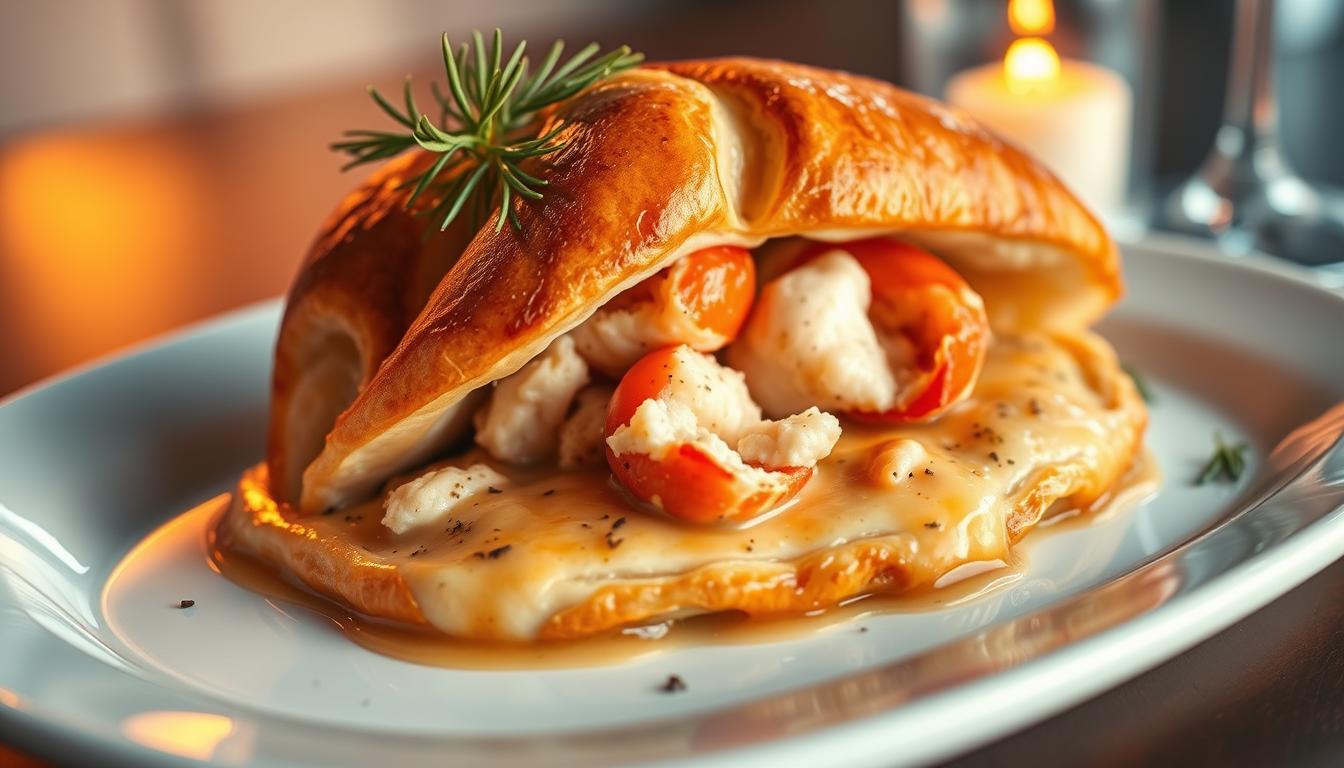Discover the ultimate gourmet seafood experience with Lobster Wellington. It’s a luxurious twist on a classic dish. This lobster recipe turns an ordinary dinner into an extraordinary dining adventure. It will impress even the most discerning food enthusiasts.
Historically, lobster was once a common meal for coastal residents. But today, it represents the pinnacle of culinary elegance. Your Lobster Wellington combines succulent seafood with delicate puff pastry. It creates a dish that bridges traditional cooking techniques with modern gastronomic creativity.
This Lobster Wellington elevates your home cooking skills. It turns an excellent ingredient into a restaurant-quality meal. The dish looks and tastes incredibly sophisticated.
Key Takeaways
- Transform ordinary seafood into a gourmet dining experience
- Learn professional culinary techniques at home
- Impress guests with a visually stunning and delicious dish
- Understand the historical significance of lobster in cuisine
- Master a complex recipe with step-by-step guidance
Understanding the Evolution of Luxury Seafood Dining
Lobster has changed a lot, from a simple coastal food to a top luxury dining choice. Its journey shows how American tastes and social views have changed over time.

Long ago, lobster was not seen as special. Coastal areas thought it was so common that they used it as fertilizer. Now, it’s a sign of fine dining.
The Historical Journey of Lobster Cuisine
Lobster’s rise to fame shows how food culture evolves. Important moments in its history include:
- 1621: Lobster was at the first Thanksgiving
- 18th Century: It was enjoyed by all social classes
- Industrial Revolution: Canning made it more accessible
- Early 20th Century: Luxury hotels and railroads made it more prestigious
Modern Interpretation of Classic Dishes
Today, chefs make lobster into new, exciting dishes. From lobster bisques to fancy Wellingtons, it shows off creativity and taste. Social media like Instagram has made lobster a trendy luxury food.
From Common Food to Culinary Delicacy
Lobster’s move from a common food to a gourmet choice shows big changes in food culture. Now, it’s on fancy restaurant menus and at special events. People love lobster not just for its taste, but also for its sustainability and creative cooking.
Essential Ingredients for Lobster Wellington

Making an easy lobster Wellington means picking top-notch ingredients. This turns a fancy dish into something simple to make. The secret to a great lobster recipe is using the best parts to make your meal special.
Your Lobster Wellington ingredient list should include:
- Fresh lobster meat – Choose tender, sweet lobster meat from cold-water areas
- Puff pastry sheets – Pick high-quality, thawed sheets
- Cremini or button mushrooms for duxelles
- Fresh herbs like thyme and parsley
- Dijon mustard
- Heavy cream
- Egg wash for golden pastry
When making your easy lobster Wellington, focus on the quality of your ingredients. Fresh lobster meat should be soft and taste sweet. Your culinary adventure starts with choosing the finest, making your dish taste like it’s from a restaurant.
Pro tip: Buy lobster meat the day you plan to cook for the best taste. Frozen lobster works too, but thaw it and pat it dry to keep the right texture in your best lobster recipes.
Kitchen Equipment and Tools You’ll Need
To make a decadent seafood dish like Lobster Wellington, you need the right tools. Preparing this impressive dinner requires careful equipment selection for culinary success. Professional chefs say the right tools make a complex recipe easy to cook.
Before starting, gather these essential kitchen tools. They will make your preparation smooth and fun.
Essential Cookware
- Large baking sheet with rimmed edges
- Heavy-bottomed saucepan for duxelles preparation
- Non-stick skillet for lobster cooking
- Reliable meat thermometer
- Silicone pastry brush
Preparation Tools
- Sharp chef’s knife
- Cutting board
- Parchment paper
- Rolling pin
- Kitchen scale for precise measurements
Serving Equipment
- Large serving platter
- Sharp serrated knife for clean slicing
- Warmed dinner plates
- Garnish tools
- Cake server or wide spatula
Quality kitchen tools make Lobster Wellington easy to achieve. With these, you’ll create a dish that will wow your guests.
Preparing the Perfect Puff Pastry Base
Starting your elegant dish begins with the puff pastry base. The Lobster Wellington needs a golden crust that matches its rich filling. Your puff pastry will turn simple ingredients into a dish fit for a restaurant.
When picking your puff pastry, you have two main choices:
- High-quality store-bought frozen puff pastry
- Homemade puff pastry for true culinary enthusiasts
To get the perfect puff pastry base, follow these steps:
- Thaw frozen puff pastry in the fridge for the best texture
- Roll out the pastry on a lightly floured surface to about 1/8 inch thickness
- Cut the pastry into precise rectangles, leaving a 1 cm border for sealing
- Chill the rolled pastry for at least 15 minutes before assembly
Temperature control is key for your Lobster Wellington’s success. Preheat your oven to 200°C (392°F). Keep your pastry cool until baking. This ensures flaky, crisp layers that make Wellingtons stand out.
“The secret to perfect puff pastry is patience and precision.” – Professional Chef
Pro tip: Brush your pastry with an egg wash for a stunning golden sheen. Your Lobster Wellington will be the star of any meal.
Mastering the Mushroom Duxelles
Making the perfect mushroom duxelles is key to a great lobster recipe. This mix turns a simple dish into a masterpiece that wows everyone.
For your Lobster Wellington, start with top-notch mushrooms. The best choice is 16 oz of baby bella mushrooms. They add rich, earthy flavors that pair well with lobster.
Selecting the Best Mushrooms
- Choose fresh, firm baby bella mushrooms
- Look for mushrooms with no dark spots or moisture
- Clean mushrooms gently with a damp paper towel
Seasoning and Cooking Techniques
Seasoning and cooking are crucial for great duxelles. Use 2 tablespoons of olive oil, 1 teaspoon of sea salt, and ½ teaspoon of black pepper. These add to the mushrooms’ natural taste.
Achieving the Perfect Texture
To get the perfect duxelles, chop the mushrooms finely and cook them slowly. Aim for a paste-like consistency. This will make your lobster dish truly gourmet.
Pro tip: Cook the mushrooms over medium heat, stirring often. This prevents burning and ensures even moisture reduction.
Lobster Wellington: Step-by-Step Assembly Guide
Making an easy lobster Wellington needs care and patience. This guide will help you turn your seafood into a beautiful dish. It will be as good as the best lobster recipes.
Start by picking the right ingredients and layering them wisely. Here are the key steps to make your Lobster Wellington perfect:
- Prepare your cooked lobster meat, making sure it’s clean and dry
- Make a thin layer of mushroom duxelles on your puff pastry base
- Put the lobster meat in the center of the pastry
- Fold the pastry edges gently to seal the lobster inside
- Brush the outside with an egg wash for a golden, crispy look
The secret to a great easy lobster Wellington is balance. Be precise when wrapping to avoid soggy pastry. You want a crispy outside that shows off tender lobster inside.
- Use cold pastry for easier handling
- Work fast to keep the butter in the pastry cold
- Trim off extra pastry for a neat look
Professional chefs say to chill the assembled Wellington for 15 minutes before baking. This keeps it firm.
With practice, you’ll get better at this impressive dish. It turns simple ingredients into a memorable meal.
Temperature Control and Cooking Times
Mastering temperature control is key for a luxury dining experience like Lobster Wellington. Your dinner idea shines with precise cooking. This ensures both safety and great taste.
The FDA says seafood should be cooked to 145°F (63°C) for safety. This temperature makes sure your lobster is cooked right. It also keeps foodborne risks away.
Essential Temperature Guidelines
- Preheat your oven to 400°F for optimal pastry golden-brownness
- Use a reliable meat thermometer to check internal lobster temperature
- Aim for an internal temperature of 140-145°F for tender, succulent lobster
Cooking time is about 20-25 minutes, depending on the Wellington’s thickness. Patience is key in creating a truly remarkable dish.
Professional chefs recommend monitoring temperature closely to prevent overcooking and maintain the lobster’s delicate texture.
Let your Lobster Wellington rest for 5-10 minutes after cooking. This lets the juices spread evenly. Your guests will be amazed by your culinary skill and attention to detail.
Presentation and Plating Techniques
Make your Lobster Wellington look stunning by mastering presentation. The way your dish looks can make the meal even better. Choose a clean, white plate to contrast with the golden pastry and lobster.
Use a sharp knife to slice the Wellington. This will help you get clean cuts that show off the lobster and mushroom layers. Try to make slices 1-2 inches thick to highlight the pastry and filling. Artistic presentation can make diners enjoy their meal up to 50% more, so take your time.
Add some microgreens or edible flowers to your plate for a fancy touch. A bit of herb-infused butter or béarnaise sauce can also enhance the flavors. Using the rule of thirds in plating can make your dish look as good as it tastes.
Finish with side dishes that match the Lobster Wellington’s flavors. A small herb salad or roasted vegetables can be a great choice. This will make your meal feel like it’s from a fancy restaurant, impressing your guests.

